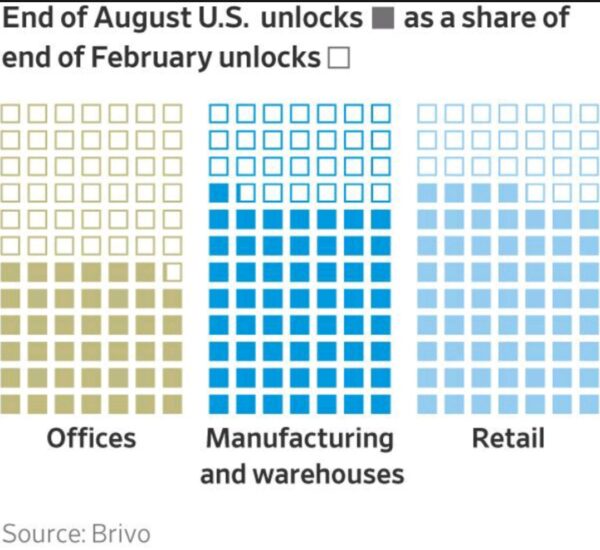Many of us have become accustomed over the last several months to working from home. The commute is easy, the apparel is ubercasual, though the food, booze, and general fun don’t match the options in a downtown business district.
Given the necessity that has become a habit, not to mention the decreased cost of doing business for both employees and companies, employers and business analysts are starting to ask the question: Will most people ever return to the office? Six months into COVID, it hasn’t happened yet.
Information from Brivo, a firm that makes access-control systems for offices, shows that “unlocks” at offices—when an employee uses their creds to enter an office—in late August were down 51% from the end of February. Visits to manufacturing and warehouse locations, where fewer jobs can be done remotely, remained down by a third.

The Wall Street Journal reports, “Returns to workplaces vary widely by location. Some cities, like New York and San Francisco, have been more conservative about reopening across the board, with offices, retail, and manufacturing and warehouses all still well below 50% of their pre-pandemic activity. In Miami, which is dependent on tourism, employee visits to retail stores were at 92% of their pre-pandemic occupancy during the last week in August; in San Francisco, they were at 43%. Other cities, like Chicago and Washington, D.C., are returning somewhat unevenly, with manufacturing and warehouses around 75% their normal activity, but offices still half-empty.” The implications of this could be staggering to the American lifestyle. And it’s not just happening here, but all over the world.
125,000 Siemens employees can now work from anywhere, indefinitely. https://t.co/ZlYEHOKlAH
— Dror Poleg (@drorpoleg) July 22, 2020
The modern office is in its current form mainly a 20th century construct that sought to centralize operations and thus bring greater efficiency to business operations. From stately Wall Street brokerages to the Bauhaus wonder of the Pan Am Building, the concept of the office played a large role in many daily lives up until this spring. It may not be gone forever. But it may be changed forever.
As social cohesion drops because of less office personal interaction, what will happen to American institutions like the office party or office romances? Though in these days of corporate bluestocking PC sensitivity to even the hint of office hijinks, those practices could have been on their way out the door anyway.
Will the reduced amount of commuters lead to less pollution? Though, if less commutes then who pays the tolls that keep the roads in shape? If fewer business lunches, what will happen to the restaurants, bars, chain eateries, and a host of support services that cater to the office worker during the day?
Many experts believe the situation will stabilize by mid next year and a majority of office workers may go back to their offices or cubicles. However, those same experts also predict up to 40 percent of people may not go back at all, as their firms work out stay at home careers as the norm. No matter how it shakes out, the physical business environment will change. Hopefully one way or the other, for the better.

Join the Discussion
COMMENTS POLICY: We have no tolerance for messages of violence, racism, vulgarity, obscenity or other such discourteous behavior. Thank you for contributing to a respectful and useful online dialogue.